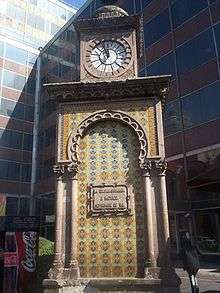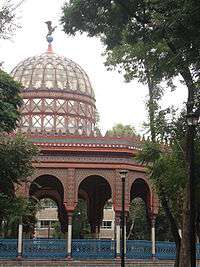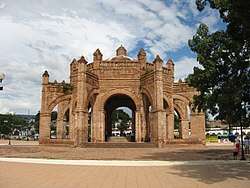Arab Mexicans
| Total population | |
|---|---|
| 1.1 million | |
| Regions with significant populations | |
| Mostly in Mexico City | |
| Languages | |
| Mexican Spanish, Arabic | |
| Religion | |
| Majority Christianity,[1] MinorityIslam | |
| Related ethnic groups | |
| Arabs, Jews, Spanish Mexicans |
Arab Mexicans are Mexican citizens of Arab ethnic, cultural and linguistic heritage or identity, who identify themselves as Arab. The vast majority of Mexico's 1,100,000 Arabs are of Lebanese, Saudi Arabian, Syrian, Iraqi, Moroccan, Yemeni and Palestinian descent.[2]
The inter-ethnic marriage in the Arab community, regardless of religious affiliation, is very high; most community members have only one parent who has Arab ethnicity. As a result of this, the Arab community in Mexico shows marked language shift away from only Arabic. Only a few speak any mainly Arabic, and such knowledge is often limited to a few basic words. Instead the majority, especially those of younger generations, speak Spanish as a first language. Throughout the Arab slave trade Arabic and Spanish have collided in Mexico as a mixture of languages and put into one which is spoken more than the original Arabic.
Migration history
Arab immigration to Mexico started in the 19th and early 20th centuries.[3] Roughly 100,000 Arabic-speakers settled in Mexico during this time period. They came mostly from Lebanon, Syria, Palestine, and Iraq and settled in significant numbers in Nayarit, Guanajuato, Puebla, Mexico City and the Northern part of the country (mainly in the states of Baja California, Tamaulipas, Nuevo Leon, Sonora, Sinaloa, Chihuahua, Zacatecas, Coahuila, and Durango), as well as the cities of Tampico and Guadalajara . They also came for slave trade in the 18th century. The term "Arab Mexican" may include ethnic groups that do not in fact identify as Arab.
During the Israel-Lebanon war in 1948 and during the Six-Day War, thousands of Lebanese left Lebanon and went to Mexico. They first arrived in Veracruz. Although Arabs made up less than 5% of the total immigrant population in Mexico during the 1930s, they constituted half of the immigrant economic activity.[4]
Immigration of Arabs in Mexico has influenced Mexican culture, in particular food, where they have introduced Kibbeh, Tabbouleh and even created recipes such as Tacos Árabes. By 1765, dates, which originated from the Middle East, were introduced into Mexico by the Spaniards. The fusion between Arab and Mexican food has highly influenced Yucatecan cuisine.[5]
Another concentration of Arab-Mexicans is in Baja California facing the U.S.-Mexican border, esp. in cities of Mexicali in the Imperial Valley U.S./Mexico, and Tijuana across from San Diego with a large Arab American community (about 280,000), some of whose families have relatives in Mexico. 45% of Arab Mexicans are of Lebanese descent.
The majority of Arab-Mexicans are Christians who belong to the Maronite Church, Roman Catholic, Eastern Orthodox and Eastern Rite Catholic Churches. A scant number are Muslims of Middle Eastern origins.



Figures
| Arab net migration to Mexico from 1871 to 1976 | ||||
|---|---|---|---|---|
| Year period | Arab immigrants | |||
| 1871–1880 | 672 | |||
| 1881–1890 | 3,537 | |||
| 1891–1900 | 10,572 | |||
| 1901–1910 | 35,398 | |||
| 1911–1920 | 39,052 | |||
| 1921–1930 | 18,894 | |||
| 1931–1940 | 1,682 | |||
| 1941–1950 | 2,063 | |||
| 1951–1960 | 1,083 | |||
| 1961–1970 | 278 | |||
| 1971–1976 | -30 | |||
| Total | 113,201 | |||
Notable people
- Carlos Slim, business magnate, investor, and philanthropist. Slim's parents are both Mexicans of Lebanese Maronite Catholic descent.
- Emeraude Toubia, actress and model raised in Brownsville, Texas, half Lebanese via her father and half Mexican via her mother.
- José Antonio Meade Kuribreña, economist, lawyer and diplomat and current Mexican Secretariat of Foreign Affairs of Lebanese and British descent.
- Pedro Joaquín Coldwell, politician affiliated to the Institutional Revolutionary Party (PRI) of Lebanese and English descent.
- Emilio Chuayffet, lawyer and politician, the incumbent Secretary of Public Education of Mexico of Lebanese descent.
- Enrique Dau, former mayor of Guadalajara, grandson of the Lebanese emigrant Wadih Dau[6]
- José Murat Casab, former Governor of Oaxaca and a member of the Institutional Revolutionary Party of Iraqi descent.
- Alfredo Harp Helú, Mexican businessman of Lebanese origin.
- Salma Hayek, actress; she is half Lebanese via her father.
- Pépé Abed, Lebanese-born Mexican jeweler returned to Lebanon after 40 years.
- Victor Nacif, Vice President of Design Business Aspects for Nissan Design America, of Iraqi descent.
- Mauricio Féres Yázbek (Garcés), actor of Lebanese descent from Tampico, Tamaulipas
- Alfonso Petersen Farah, mayor of Guadalajara. German, Danish and Lebanese descent.
- Emilio Hassan, footballer, nephew of Carlos Slim, of Lebanese descent.
- Paul Ham, bassist for Anabantha, of Lebanese descent.
- Ricardo Dájer Nahum, Mexican politician of Lebanese origin.
- Jeff Becerra, Heavy metal musician of Lebanese descent.
- Capulina, actor of Lebanese descent.
- Jaime Camil, Actor, singer of Egyptian and Brazilian descent.
- Isaac Saba Raffoul, businessman of Syrian descent.
- Astrid Hadad, Mexican actress of Lebanese descent.
- Miguel Sabah, a Mexican international footballer of mixed Palestinian/Mexican/Lebanese descent
- Liliana Abud, an actress in telenovelas and Mexican cinema.
- José Sulaimán, President of the World Boxing Council, Lebanese descent.
- Antonio Mohamed, Argentine-born Mexican soccer player of Lebanese descent.
- Samer Omar, football player currently playing for Tiburones Rojos de Veracruz. He is of Lebanese background.
- Kamel Nacif Borge, Mexican businessman of Lebanese descent.
- Jesús Murillo Karam, Mexican politician of Lebanese descent.
- Susana Harp, Mexican singer of traditional music of Lebanese and Mexican descent.
- Omar Fayad, Mexican politician of Lebanese descent.
- Rosemary Barkett, U.S. Federal Judge to Syrian parent.
- Jorge Kahwagi, Mexican boxer, lawyer, businessman, and politician of Lebanese descent.
- Carlos Jiménez Mabarak, Musician of Lebanese descent.
- Ikram Antaki, Mexican writer of Syrian origin.
- Arturo Elías Ayub, Mexican businessman of Lebanese descent.
- Alfredo Elias Ayub, Director General of Federal Electricity Commission, Arturo Elías Ayub is his youngest brother, of Lebanese descent.
- Bibelot Mansur, actress born to a Mexican mother and a father of Lebanese descent.
- Miguel Layún, a Mexican international footballer of Lebanese and Spanish descent.
- Jerónimo Amione, a Mexican footballer of Lebanese and Mexican descent.
- Jaime Sabines, a Mexican poet of Lebanese descent.
- Alejandro Bichir, a Mexican actor of Lebanese and Mexican descent.
- Bruno Bichir, a Mexican actor of Lebanese and Mexican descent.
- Demián Bichir, a Mexican actor of Lebanese and Mexican descent.
- Odiseo Bichir, a Mexican actor of Lebanese and Mexican descent.
- Jorge Estefan Chidiac, Mexican politician of Lebanese descent
- María de Lourdes Dieck-Assad, Mexican economist of Belgian and Levantine descent.
See also
External links
References
- ↑ Marin-Guzman, Roberto and Zidane Zeraoui. Arab Immigration in Mexico in the Nineteenth and Twentieth Centuries: Assimilation and Arab Heritage. (Book Review) Industry & Business Article – Research, News, Information, Contacts, Divisions, Subsidiaries, Business Associations
- ↑ "Archived copy" (PDF). Archived from the original (PDF) on 2009-03-27. Retrieved 2010-04-17.
- ↑ Marin-Guzman, Roberto and Zidane Zeraoui. Arab Immigration in Mexico in the Nineteenth and Twentieth Centuries: Assimilation and Arab Heritage.(Book Review) Industry & Business Article - Research, News, Information, Contacts, Divisions, Subsidiaries, Business Associations
- ↑ "Archived copy" (PDF). Archived from the original (PDF) on 2009-03-27. Retrieved 2010-04-17.
- ↑ Discovery Mexico: Travel Guide and Booking - Discovery Mexico
- ↑ El emigrante libanés vigila Guadalajara